ASUS K53E: Testing Dual-Core Sandy Bridge
by Jarred Walton on April 8, 2011 1:00 AM EST- Posted in
- Laptops
- Intel
- Sandy Bridge
- Asus
Sandy Bridge Gaming Performance, One More Time
After the 3DMark results, and considering our previous look at SNB’s GPU performance, there’s not much new to say here. We’re still working on a full roundup of gaming performance and compatibility testing with Sandy Bridge, similar to what we did with the AMD E-350. Our standard suite of laptop gaming tests all ran without any apparent compatibility problems, but given this list hasn’t changed much Intel has had ample time to make sure these titles work. We’ve run the Low and Medium performance tests, with a selection of competing laptops in the charts below.
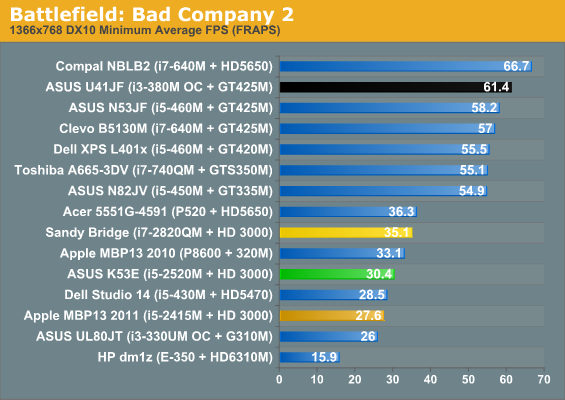
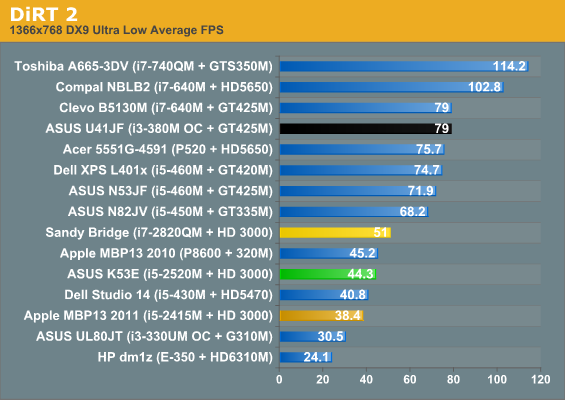
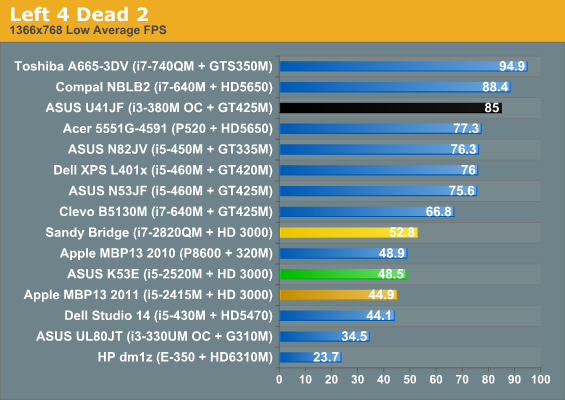
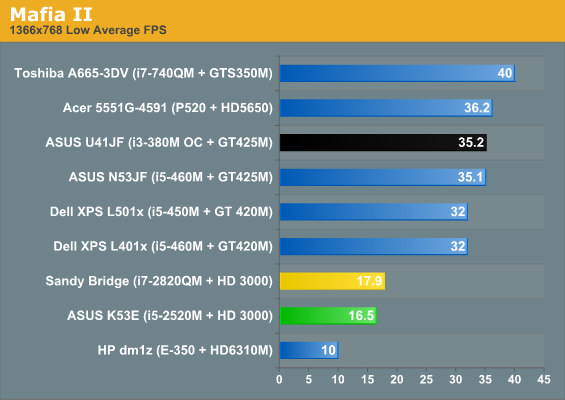
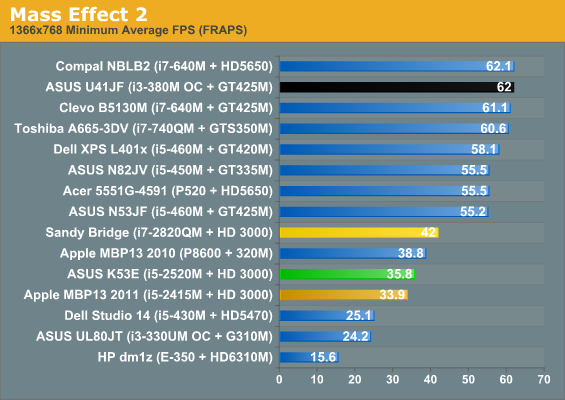
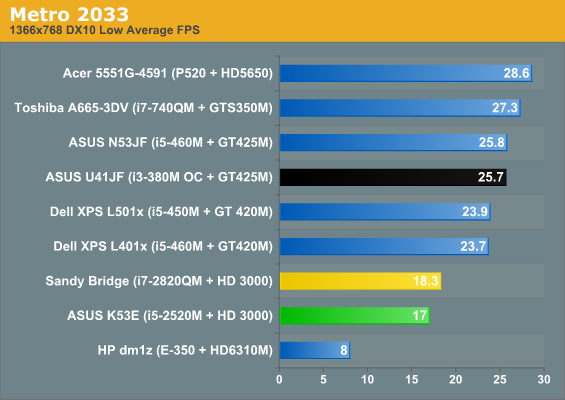
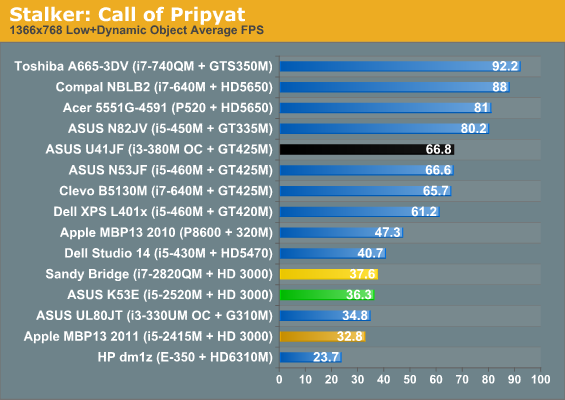
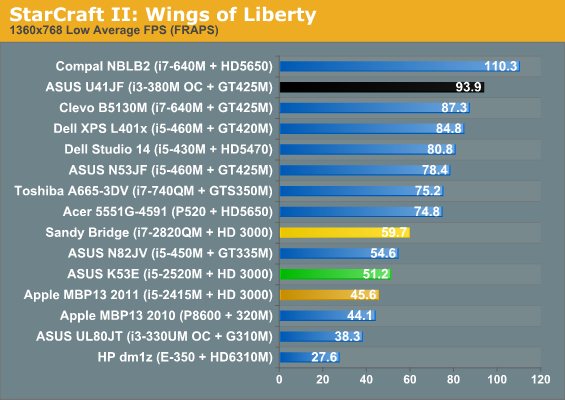
As we noted in the ASUS U41JF review, Intel’s relative standings in graphics are better with 3DMark than with actual games, particularly when we look at midrange GPUs like the GT 425M and HD 5650. Where the U41JF leads the K53E by 53% in the four 3DMark tests, in our eight actual games at low detail that increases to an 82% advantage. The K53E still leads the MBP13 2011 by 10%, and the i7-2820QM in turn leads the K53E by 12%—those results are the same as 3DMark, but then we’re dealing with the same IGP in all those cases. In terms of actual performance, the K53E breaks the 30FPS mark in six of the eight titles—Mafia II and Metro 2033 being the standard exceptions, but then those often fail to break 30FPS even on discrete GPUs.
What about the AMD E-350 comparison? As we just finished discussing, 3DMark shows the K53E coming in 125% faster than the E-350, though as we’ve noted in the past 3DMark can either skew things too much or too little towards CPU performance. Move over to our suite of games and the K53E still posts much higher scores than the E-350, but now the margin of victory is 88%. That’s still nearly twice the performance, and for a complete laptop you’re looking at around $725 versus $500 for similar components elsewhere. 45% more money for 88% faster graphics and 300% faster CPU performance isn’t a bad deal; what you don’t get with Sandy Bridge at that price is 8+ hours of battery life in an 11.6”-screen chassis.
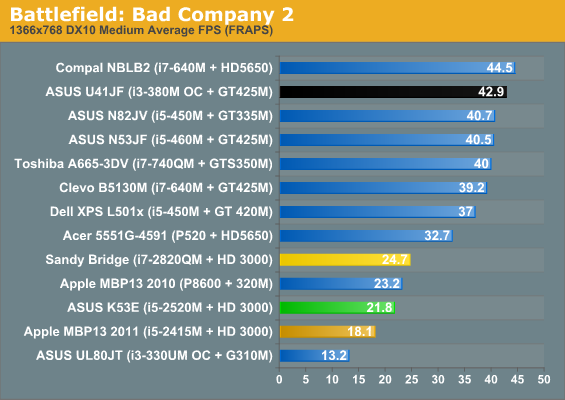


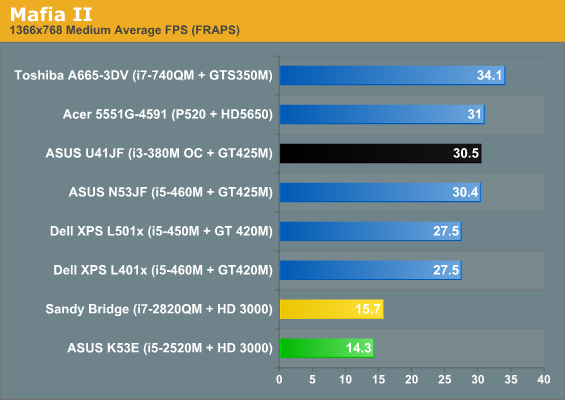

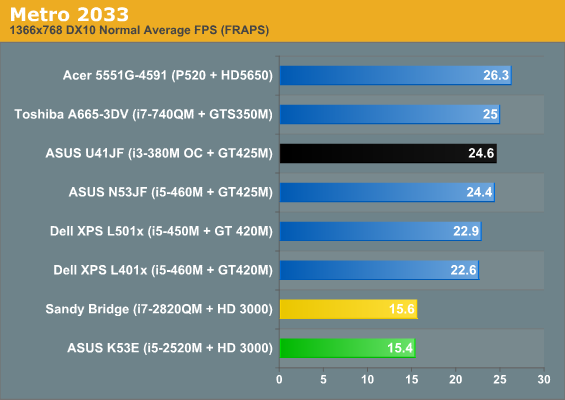
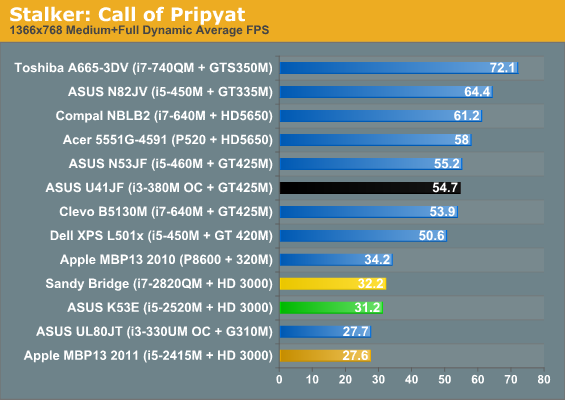
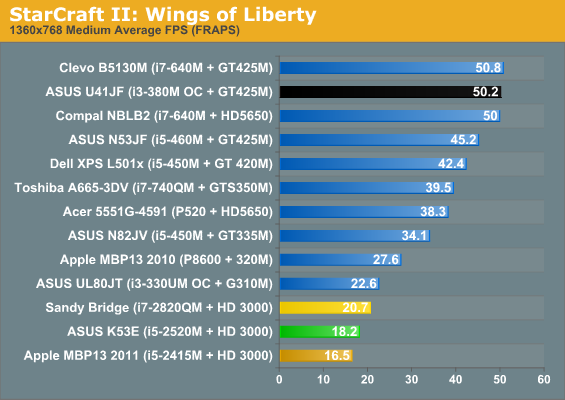
At medium detail settings, HD 3000 performance drops relative to the discrete GPUs. The K53E manages to hit 30FPS or higher in exactly one game this time: STALKER. It’s still 11% faster than the MBP13 2011, and the 2820QM is 14% faster than the K53E. Interesting to note is that the MBP13 2010 is also 15% faster than the K53, putting the GeForce 320M on the same level as the HD 3000 with quad-core CPU. By far the more pertinent piece of information is just how badly the U41JF trounces the K53E: Arrandale with a midrange dGPU comes out nearly 100% faster on average at our “Medium” settings, and it breaks 30FPS in every game in the list except Metro 2033.
For people looking to get an all-around laptop that can play games and provide adequate performance for general use, discrete GPUs are still required. Even then, midrange mobile GPUs are going to struggle with a lot of titles unless you turn down the detail settings and run at moderate (e.g. 720p) resolutions. On the other hand, if you’re not serious about gaming and graphics, Sandy Bridge’s IGP is very likely to satisfy the vast majority of users. Thankfully, it also manages to raise the bar relative to previous IGPs, with roughly double the performance of Arrandale’s HD Graphics and AMD’s HD 4250.
Rounding out the graphics discussion, other areas where the GPU helps also performed well. Viewing HD 1080p YouTube videos worked without any issues I could detect, thanks at least in part to the latest release of Adobe’s Flash player. Casual browser games like Bejeweled Blitz also worked fine, which isn’t something I could say on Arrandale where there was always a slightly perceptible delay—and that’s also a complaint I had with Brazos, which didn’t do well with Bejeweled Blitz. One interesting piece of information, however, is that the K53E really did poorly in Civilization V testing (not shown here, but you can see the scores in Mobile Bench), but whether that’s a driver problem or something else I can’t say.
Overall, gaming and graphics isn’t an absolute victory for Intel’s latest IGP, but it’s good enough for a large percentage of users. In the next month or so, we’ll see AMD’s counter to SNB with their second Fusion APU, Llano. That should provide at least double the GPU performance of Brazos, and even the aging K10.5 CPU core is a huge step up in performance from Bobcat. The combination should put Llano well ahead of HD 3000 in gaming, but whether it will be 50% faster or 100% faster we can't say for certain.
With a 32nm process technology and better use of power gating, Llano is going to be an interesting alternative, especially if the total system cost is similar to the $500 to $650 we’re seeing on current AMD notebooks. Sandy Bridge is unlikely to be touched for CPU computations by any of AMD’s mobile CPUs for the remainder of 2011, but with up to 400 Stream Processors Llano should come relatively close to the HD 6500 (HD 5600) series GPU performance. Put another way, while Intel’s HD 3000 is about twice the performance of Brazos’ IGP, Llano could easily double HD 3000. It’s a welcome change from the 15 to 25% improvements in IGP performance we often saw in previous platforms.










78 Comments
View All Comments
Tasslehoff Burrfoot - Friday, April 8, 2011 - link
I'm a little surprised this laptop has such a long battery life.If manufacturers put as good batteries to the fusion laptops as Asus put into this one they could last a looong, loong time.
krumme - Friday, April 8, 2011 - link
I have 97 Wh on my 2520 machine, and it last 10-12 hr for office work. Its just a little bit short even for light gaming for my 2-3 years old games imho, but besides from that, it just delivers in spades. The fan is never on, and the laptop is not hot. Even decoding hd there is only very, very little heat and noise.silverblue - Friday, April 8, 2011 - link
I think comparing the following two ASUS models would make interesting reading:http://www.newegg.com/Product/Product.aspx?Item=N8...
http://www.newegg.com/Product/Product.aspx?Item=N8...
The former is a Pentium with HD 5470 discrete graphics and carries a $100 price premium (and has recently been reduced $200).
Acer do a cheaper Brazos laptop, however it's much larger at 15.6":
http://www.newegg.com/Product/Product.aspx?Item=N8...
789427 - Friday, April 8, 2011 - link
I don't know but I just may be getting old.To me the notebooks are pretty much all fast enough unless you're going for a desktop replacement and quite frankly, I can't see myself without a desktop (I like my 23" monitor but would never carry it around)
My on the go machine is a compaq 311c with 7200rpm 500gb HDD - a netbook and I never find myself apologizing for it's slowness.
So I asked myself, what makes a notebook noteworthy...
1. The right screen for the form factor
2. Battery life
3. Capabilities: can it play Blu-ray? 720p?
4. Is it fast enough?
5. does the keyboard work - or is it a Sony (Sorry Sony - you produced the worst keyboard ever in your netbook - can't remember the model)
When I saw the AMD video of the new processors when a video was playing, excel calculating the hind legs off a donkey on Mars and switching between the lot, I realized that Benchmarks are extremely limited and don't have a relationship to the real-world .
Real world benchmark: Hours of blu-ray playback
Can I type emails, letters while watching a windowed movie?
Can I watch while running a photoshop batch conversion? Text recognition?
And for a gaming laptop - what games can I play...
Am I nuts? Probably but somehow I think AMD is on to something. Oh wait... Apple is already there. How else could they charge the prices they do for a last-gen Intel CPU? It's by focusing on the entire build - especially the screen and design.
cb
Pirks - Friday, April 8, 2011 - link
Apple did the right thing getting rid of this legacy shit and I'm waiting for other molasses slow PC vendors to follow their lead. You don't need any stupid touchpad buttons when you have tap, multitap and multitouch on your touchpad, it's 2011 not 2001 for ducks sake, why use legacy tech now? I don't get it. I never ever touched touchpad buttons on my Asus UL80Vt since its touchpad has same left right middle click and scroll with multitouch, Apple-like and pretty nice and convenient to use.Stop being such a retro man Jarred, let the museum stuff go, will ya? ;)
JarredWalton - Friday, April 8, 2011 - link
No thank you... I hate the Apple touchpad where you actually have to physically "click" it. Anyway, my point was that I'm glad there's no silly rocker button (i.e. UL80Vt) this time. I also happen to do things like pushing the left button and then dragging over an area to select. Yes, you can double-tap-and-drag, but that sucks IMO. Anyway, you know what they say about opinions and a-holes. :)DanNeely - Monday, April 11, 2011 - link
I have to agree with Jarred. Tap to click == fail.ProDigit - Friday, April 8, 2011 - link
I wonder when the first manufacturer is going to create a HTPC, booksized pc, or mini pc, with a mobile Corei7 chipset, together with a powerful mobile graphics card, or a very energy efficient desktop graphics card!I think there'd be a lot of interest in a 64 or 128GB SSD, 2 or 4 x 4GB 1800Mhz DDR3 memory, the corei7 2820-QM processor, an ATI Radeon HD 5000 or 6000 series graphics card that is not the best of the best, but offers highest quality dx11 gaming for 1080p screens, or fluid dx9 gaming on 3 screens, together with IR sensor and remote control, and uses very little power in standby.
I see plenty of sub $100 variants with too slow processors to play back 1080p video on a tv.
drajitsh - Saturday, April 9, 2011 - link
posting after nearly 10 years.Well having followed Anandtech continuously for 11 years I do know a little bit about computers. therefore I get a pretty fair idea of the performance from the specs online and most vendors will give pics of their systems so any glaring ergonomic defects will be visible.
Since sandybridge I just read the initial review for the platform, the for the subsequent reviews I go directly to the screen review. If, as is usually the case, the screen is pathetic I go back to my Galaxy Tab.
I am a surgeon, so my tablet and my old core 2 duo more than take care of the bulk of my needs -- mainly web surfing, having memorised the keyboard shortcuts I find the ribbon interface clunky and obsteperous and even office 97 would probably do all the work I need.n hence open office and google docs.
I am making do with my core 2 duo -- nice keyboard ( with real keys and not a chiclet monster) a 16:10 screen ( I have other options if I want to see movies and I like to see more of the webpages or documents). the one thing I cannot indulge is my hobby of photography. Probably will continue doing so till they come out with something with a better screen with a Adobe RGB gamut and taller than 16: 10.
I guess I will be waiting for sometime still.
ProDigit - Saturday, April 9, 2011 - link
quote:"There’s little (well, nothing really) to recommend an Atom netbook over a Brazos alternative at the $300 to $350 price bracket"
You forget battery life, which is important for many!
Atom netbooks have very low latency in audio applications, and have a long battery life.
I rather pay $300 for a netbook that does basic computing for 10 hours, than pay $400 for a neo that can do basic gaming, but only lasts 4 hours on battery!